Seagate Enterprise NAS HDD 6 TB Review
by Ganesh T S on December 10, 2014 8:00 AM EST- Posted in
- NAS
- Storage
- Seagate
- HDDs
- Enterprise
RAID-5 Benchmarking - Miscellaneous Aspects
Consumers are rightly worried about RAID rebuilds and the scope for drive failures during that process. As one of our evaluation aspects, we randomly yanked out a disk during operation and cleaned it up for rebuild. We recorded the resync duration (time taken to rebuild a 3-disk RAID-5 volume when one of the disks needs to be replaced) as well as the average power consumption during that process. The two aspects, considered together, give an idea of the efficiency of the hard drive. The graph below presents the total energy consumption (Resync Power Consumption (W) X Resync Duration (s)) for the resync.
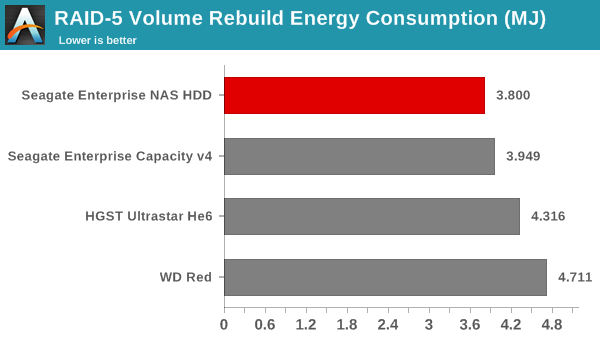
While the energy consumption aspect provides a consolidated view of the various factors, it is still worthwhile to look at the power consumption and resync duration numbers separately. The table below provides the raw information behind the above graph. The numbers are very similar to the Enterprise Capacity v4, with a slight edge for the Enterprise NAS HDD.
| RAID-5 Resync Power Consumption & Duration | ||
| Drive | Power (W) | Duration (s) |
| Seagate Enterprise NAS HDD | 101.91 | 37284 |
| WD Red | 90.48 | 52072 |
| HGST Ultrastar He6 | 95.36 | 45260 |
| Seagate Enterprise Capacity v4 | 105.42 | 37462 |
We also measured power consumption during the last stage of our multi-client test. With 25 different clients simultaneously stressing the NAS with different types of workloads, we recorded the power consumption at the wall for the NAS as a whole. The various numbers are presented in the graphs below.
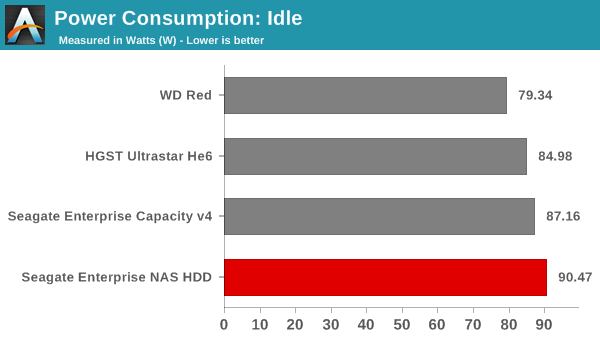
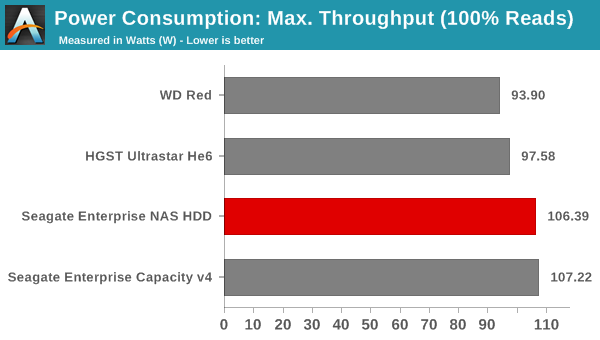
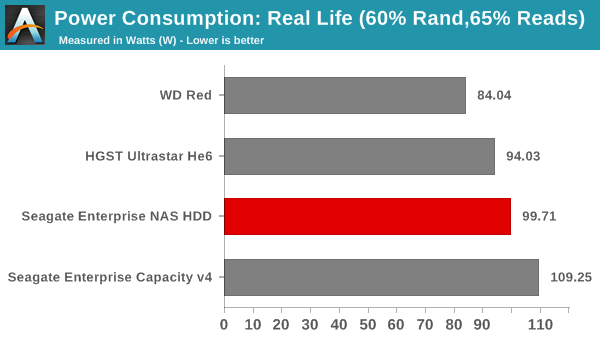
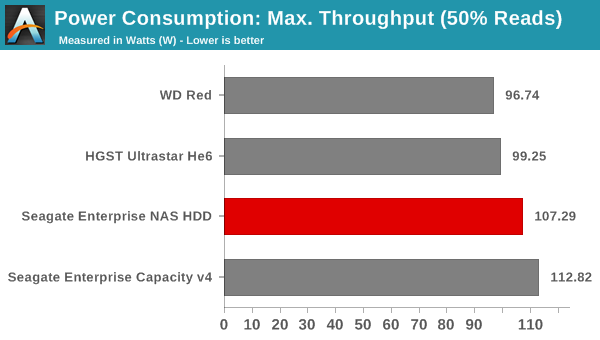
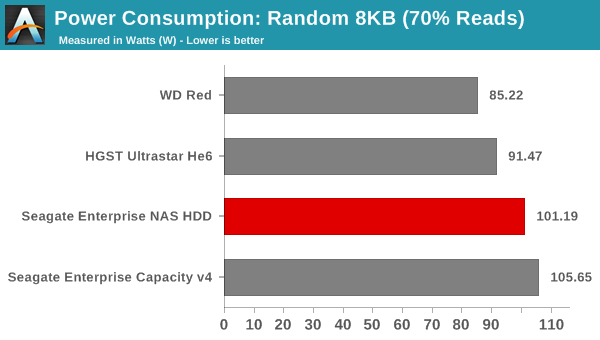
As expected, the units providing better performance have higher power consumption numbers. Workload numbers closely track the rebuild power consumption. The HGST Ultrastar He6, while providing equivalent performance, manages to keep the power consumption low because of the sealed Helium-filled environment for the platters. The Seagate Enterprise Capacity v4 and Enterprise NAS HDD are traditional hard drives that are able to achieve the capacity points using platters with higher storage density (six platters with 1TB/platter).










51 Comments
View All Comments
nathanddrews - Wednesday, December 10, 2014 - link
What's the status of this drive's APM setting? Do the heads park frequently and make a lot of clicking noises? Can you enable/disable it using the driver or something like HDParm? Lately I've been less trusting of Seagate's HDDs because they don't allow user-controlled APM settings on many of their models. I have sufficient cooling in my rack, but half the drives I have are firmware locked with aggressive APM.Samus - Wednesday, December 10, 2014 - link
After reading the review, I'd probably go for the Hitachi HE6 if these drives were priced close together. The feature set and more advanced nature of the Hitachi make it more attractive. I get that whole "not tried and true" helium technology argument, but the warranty is the same.cm2187 - Wednesday, December 10, 2014 - link
I've read somewhere that the HGST Deskstars 6TB will be released soon. If they live by their predecessors, it's probably a more reliable substitute for the WD Red without the cost of the Seagate drives.Samus - Wednesday, December 10, 2014 - link
I agree. Hitachi drives are excellent. If price isn't a factor (they're all the same price) then it's a no brainer.Laststop311 - Thursday, December 11, 2014 - link
Oh yea, after seeing the prices $420 for the seagate nas is only $30 cheaper and you'll make the 30 dollars back in power savings over the life of the drive. And the enterprise seagate is $50 more! They also consistently fail to mention that the He6 has less turbulence and friction from the platters spinning in a less dense environment. Less turbulence = less vibration and less vibration = less acoustic output. Also because of the helium environment the motor that spins the drive is slightly less powerful than standard motors since it uses less energy to spin platters inside helium versus air. Less powerful motor also means less vibrations from the motor. It's the quietest 7200 rpm 6TB HDD without a doubt.Laststop311 - Wednesday, December 10, 2014 - link
Yeah like I've said before in 20+ years of using a PC I still do not have 1 dead hitachi drive in my possession. I've probably bought 8 or so hitachi drives in my life and they are flawless. I've had 5 Seagates break and 3 were from the same rma process like the drive that replaced the broken one broke then broke again thats how bad they are. Western Digital isn't that bad I've only had 1 of those ever break on me. Haven't had much experience with Toshiba tho.Laststop311 - Wednesday, December 10, 2014 - link
Yeah so forgot, I totally recommend the He6. I have a hard time believing the listed acoustics for the 2 drives. Seagate says their drive is 27db and the He6 is 29db. I rly highly doubt the seagate is quieter the Helium environment produces less friction and less turbulence because helium is less dense than air. Friction and turbulence causes vibration and is a huge source of HDD noise. The He6 should be the quietest 6TB 7200 rpm drive. Also tho the He6 lacks maximum transfer speed it makes up for it with the lowest latency by a good 2-3 milliseconds. So the He6 ends up feeling more snappy even tho its lower max transfer speed.Laststop311 - Wednesday, December 10, 2014 - link
Just some data to backup my claim backblaze is a cloud storage company that tracks it's hard drive failures.https://www.backblaze.com/blog/hard-drive-reliabil...
What you will see there is exactly my same experience. Hitachi has barely any failures, Seagate has a huge amount of failures way beyond every 1 else and western digital is a little worse than hitachi but better than seagate.
Laststop311 - Thursday, December 11, 2014 - link
And another thing. You can almost guarantee Hitachi has at the very least an 8TB He8 to compete against Seagates new 8TB drive waiting in the wings going through its last QA testing. If Hitachi can blend the extra platter density from helium and the extra density per platter in shingled recording being used in Seagate then they could easily blow past 8TB and make 10TB and 12TB drives as well. The helium Hitachi drive is without a doubt the most advanced hard drive platform on the market.And for massive deployments like a cloud storage service would need, the energy savings from the He6 can end up saving a lot of kWh on your power bill. But even for a home user it's nice to shave off as many watts as possible from your system without affecting performance, thats why 80+ platinum sells even tho it's only microscopically better than 80+ gold.
ddriver - Wednesday, December 10, 2014 - link
Too bad you cannot put in a review the one thing that truly matters - reliability...